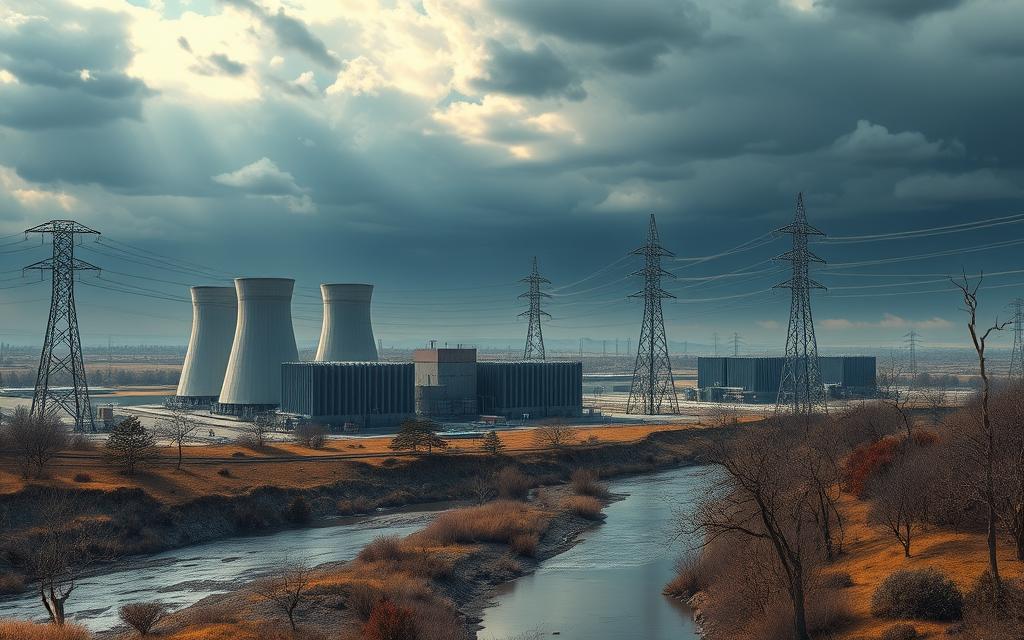How Does Cryptocurrency Mining Affect the Environment?
As cryptocurrency values soar, the environmental toll of mining comes under scrutiny. Bitcoin mining, for example, uses huge amounts of energy. This has major effects on climate change and sustainability.
United Nations scientists reveal Bitcoin uses more energy than some nations. This raises concerns about its carbon footprint. Professor Kaveh Madani points out that, despite their financial innovation, digital currencies need strict regulation. Without it, their impact on water, land, and overall environmental health is dire.
The Energy Consumption of Cryptocurrency Mining
Cryptocurrency mining’s energy use has soared to worrying levels. It’s now as much as whole countries use. For example, Bitcoin mining eats up about 173.42 Terawatt hours (TWh) annually. That’s more than nations like Pakistan need. This shows how much power the industry consumes.
Comparison to Traditional Financial Systems
The difference in energy use between cryptocurrency and traditional finance is stark. Traditional finance does use a lot of energy but in different ways. For instance, credit card transactions use energy much like some blockchain technologies that don’t require proof of work. But, cryptocurrency mining involves intense competition and price changes. This competition and the fluctuating prices of cryptocurrencies lead to a big jump in both mining activities and energy use. Electricity use has shot up by 140% because of a 400% increase in Bitcoin’s price.
Global Energy Demands of Cryptocurrency Networks
The US is at the forefront of Bitcoin mining, contributing to over a third of it worldwide. Much of the power for mining comes from fossil fuels. This fact points to a shift toward practices that could harm the environment. Bitcoin mining makes up about 0.5% of the world’s total electricity use. This is concerning for our planet. Even as mining moved from China to other places like Kazakhstan and the US, the problem just moved instead of getting fixed. Research points to a critical need for new ideas and rules to make energy use more sustainable.
The Carbon Footprint of Cryptocurrency Mining
Cryptocurrency mining, especially Bitcoin mining, is a big environmental issue. It creates a lot of greenhouse gases. A report shows that Bitcoin mining used up 173 terawatt hours of electricity recently. This is almost as much as what countries like Belgium and the Netherlands use. So, it has a huge carbon footprint.
Emissions from Bitcoin Mining
In the year 2020-2021, Bitcoin mining produced over 85.89 million tonnes of CO2. This is as much as the emissions from a whole country. The use of coal for mining makes this worse. About 45% of Bitcoin’s energy comes from coal. This shows how mining in countries like China and the USA affects the environment.
Impact of Fossil Fuels on Carbon Emissions
Fossil fuels are a major part of the energy used for Bitcoin mining. They account for 67% of the sector’s energy use globally. This reliance on coal increases CO2 emissions a lot. It makes it hard to achieve global climate goals. China’s coal-based mining alone released over 41 million tonnes of CO2. This poses big sustainability concerns and shows the need for cleaner energy.
| Aspect | Value |
|---|---|
| Annual Energy Consumption (TWh) | 173 |
| Carbon Emissions (Mt CO2) | 85.89 |
| Coal’s Share of Energy Mix (%) | 45 |
| Fossil Fuel Reliance (%) | 67 |
| Top Emitting Countries | China, USA, Kazakhstan |

Water and Land Footprints Associated with Cryptocurrency Mining
Cryptocurrency mining affects more than just electricity use. It notably has a large water and land footprint. These mining activities use lots of natural resources. This raises important environmental concerns that both regulators and the public need to consider.
Water Usage in Mining Operations
Bitcoin mining uses about 1.65 cubic kilometres of water. This is enough to fill 660,000 Olympic-sized swimming pools. This shows the huge amount of water mining operations need. The water is mostly used in cooling systems to keep the mining equipment from overheating. This vast water use could meet the needs of over 300 million people in rural areas.
Land Use Implications of Mining Facilities
Bitcoin mining takes up more than 1,870 square kilometres. This area is 1.4 times bigger than Los Angeles. The use of so much land raises issues about keeping a balance with nature and using resources wisely. As mining sites get bigger, they can harm local wildlife and ecosystems. It’s important to look closely at these effects. We need to make sure the growth of digital currencies does not harm our planet.
Cryptocurrency Mining Effect on Environment
Cryptocurrency mining has grown, bringing environmental challenges. Regions with these operations face environmental consequences. They deal with issues like increased energy use and habitat loss.
Environmental Consequences of Mining Regions
Mining relies heavily on non-renewable resources, harming the environment. Crypto mining, especially Bitcoin and Ethereum, uses a lot of energy from carbon-rich sources. This leads to a big carbon footprint, around 140 million metric tons of CO2 yearly.
Water usage is also a big concern. It’s similar to filling over 660,000 Olympic-sized pools. This affects natural water sources and clean water for people.
Efforts to Mitigate Environmental Damage
Efforts are being made to lessen mining’s effects. Many are pushing for sustainable practices, like using renewable energy. Hydropower helps a lot, providing over 16% of the energy needed for Bitcoin mining.
Regulatory plans aim to look after communities and the planet. Specialists urge leaders to follow best practices. These include recycling electronic waste. This helps the environment and makes things greener. For more on recycling, check out this link.
Sustainable Alternatives to Traditional Mining
The environmental effects of cryptocurrency mining are getting a lot of attention. It’s crucial to find sustainable alternatives to traditional mining. Moving towards eco-friendly methods can greatly reduce negative impacts. A good example is the proof-of-stake model, which is much kinder to our planet than the old proof-of-work mining.
Proof-of-Stake vs. Proof-of-Work Models
The proof-of-stake model is known for using much less energy. In this model, validators are chosen based on the amount of cryptocurrency they can offer as security, not by solving complex math problems like in proof-of-work. Ethereum has switched to proof-of-stake, cutting energy use by nearly 100%. This means much less electricity is used, and it also cuts down carbon emissions from mining.
Innovations in Renewable Energy Utilisation
Using renewable energy in cryptocurrency mining is key to becoming more sustainable. But, there’s still a big difference between how much renewable energy we can make and what mining needs. Efforts to use solar, wind, and hydro power are growing, aiming to lessen dependence on fossil fuels. These efforts are leading us towards a mining industry that has a much smaller environmental footprint.
Conclusion
The link between cryptocurrency mining and its environmental impact is urgent and needs quick action. The crypto market is booming, with Bitcoin alone valued at 115 billion dollars and more than 1,565 currencies being traded. Since 81% of the world’s energy still comes from fossil fuels, this growth sparks worry about our planet’s future.
To reduce energy use and environmental harm, we must act now. Crypto mining, especially Bitcoin, uses a lot of energy for security. This situation creates a challenge: how to keep digital finance growing without hurting the earth.
It’s time for those in charge, along with the global community, to promote green mining methods. President Biden’s Executive Order on crypto mining shows a move towards balancing tech progress with protecting nature. Together, we can find ways to make cryptocurrency sustainable, ensuring it thrives without harming our world.
FAQ
How does cryptocurrency mining affect the environment?
Cryptocurrency mining harms the environment, using a lot of energy and causing pollution. It needs vast amounts of electricity and fuels that harm our planet. This leads to climate change and damages nature.
What is the energy consumption of cryptocurrency mining compared to traditional financial systems?
Cryptocurrency mining uses a huge amount of electricity, more than some countries. Traditional financial systems use less energy. They rely on processes like credit card payments, which are less demanding.
What are the main sources of carbon emissions from cryptocurrency mining?
Fossil fuels, especially coal, are the main sources of emissions from cryptocurrency mining. This dependence releases a lot of greenhouse gases. It adds to the carbon footprint of mining activities.
How much water is used in cryptocurrency mining operations?
Mining for cryptocurrencies uses as much water as over 660,000 Olympic pools. This huge use threatens local water sources. It raises concerns about its impact on ecosystems and resource use.
What are the land use implications of cryptocurrency mining facilities?
Cryptocurrency mining takes up more land than cities like Los Angeles. It affects local ecosystems and wildlife. This raises issues about how we use and manage land.
What efforts are being made to mitigate the environmental damage caused by cryptocurrency mining?
Efforts to reduce harm include using clean energy and changing rules. The industry is moving towards sustainability. They aim to protect the environment while mining.
What are the sustainable alternatives to traditional cryptocurrency mining?
The proof-of-stake approach is a greener alternative. It uses less energy than the traditional method. Using renewable energy in mining operations cuts down on fossil fuel reliance. This helps the environment.















